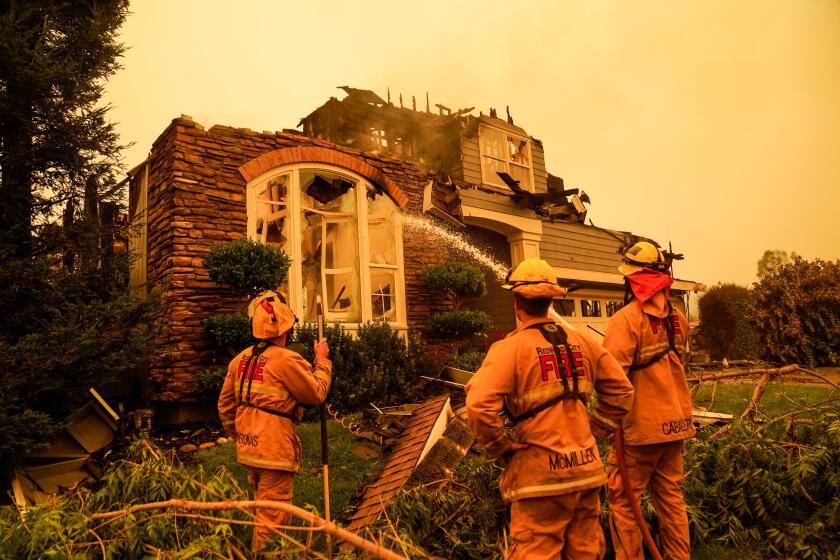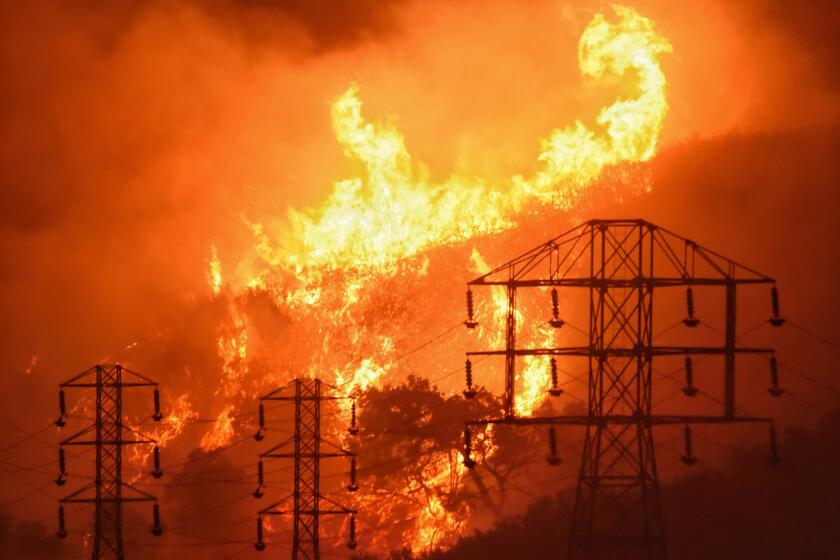PG&E outages leave tens of thousands without power as fires tear through Northern California

- Share via
ORINDA, Calif. — About 87,500 Pacific Gas & Electric customers in 16 California counties were without power Monday morning after the state’s largest investor-owned utility preemptively de-energized some of its equipment to avoid sparking wildfires and shut off power at other locations because of blazes already burning.
Roughly 11,000 customers in Butte County were scheduled to lose power early Sunday, followed by 54,000 more customers in the Central Sierra on Sunday evening and 15 in Kern County on Monday morning, the utility said in a news release.
For the record:
2:24 p.m. Oct. 1, 2020An earlier version of this article said roughly 15,000 Pacific Gas & Electric customers in Kern County were scheduled to lose power in a preemptive shutoff Sunday. Fifteen customers in Kern County were slated for the outage.
Tens of thousands of customers were also without power in Napa and Sonoma counties amid fires burning there.
In the Central Sierra, the planned outages were to include parts of 14 counties: Alpine, Amador, Calaveras, El Dorado, Lake, Napa, Nevada, Placer, Plumas, Shasta, Sierra, Sonoma, Tehama and Yuba.
Power that was shut off to prevent wildfires should be restored for all customers by Monday night, utility officials said.
Thousands of people are under evacuation orders as multiple fires burn unchecked in Napa, Sonoma and Shasta counties.
The shutoffs come as hot and dry Diablo winds moving in from the north and east have caused much of Northern California to be under a red-flag warning, with the National Weather Service forecasting continued dangerous fire weather conditions.
The warning is in effect until 9 p.m. Monday, with forecasters predicting critically low humidity and wind gusts that could reach up to 50 mph at high elevations.
A series of fast-moving wind-driven wildfires are already besieging California’s wine country, destroying numerous homes and other buildings in Napa and Sonoma counties overnight and forcing tens of thousands of people to flee.
Crews were dispatched to the initial blaze, dubbed the Glass fire, near the rural community of Igo at 3:50 a.m. Sunday, and the fire quickly grew to 20 acres, then 50, then 800, said Tyree Zander, public information officer with the California Department of Forestry and Fire Protection’s Napa-Lake-Sonoma Unit. The fire had burned 11,000 acres and expanded into Sonoma County by Monday morning.
Tamar Sarkissian, a spokesperson for PG&E, said Napa County had not been scheduled for a precautionary power outage until 5 p.m. Sunday, many hours after the start of the fire. But she said the utility had no reason to believe that its equipment sparked the blaze.
“We have not filed an electric incident report and have no information indicating that the Glass fire ignition is attributable to PG&E facilities,” she said.
Sarkissian said about 28,000 customers in Napa and Sonoma counties were without power Monday — 11,000 of them in Napa County and 17,000 in Sonoma County.
Remote weather stations, satellites and supercomputers have begun to show promise as a means of predicting the spread of wildfires.
The public power safety shutoff that started at 5 p.m. Sunday in Napa County affected 288 customers, she said. The others lost power as a result of fire damage to equipment or at the direction of Cal Fire to protect first responders, she said.
The weather service also issued a red-flag warning for swaths of Southern California as Santa Ana winds are forecast to sweep through the area. Southern California Edison said it didn’t have plans to cut power in its service area as of late Monday morning but that it was keeping a close eye on the weather in case conditions deteriorated.
“We do have fire weather expected, but right now, we’re not looking at anything that’s rising to the level for public safety power shutoffs for this week,” spokesman Robert Villegas said. “But as you can imagine, that potential is always out there, so we’re sticking pretty close with watching the weather and watching the conditions on the ground in case there’s some sort of change that requires us to activate a team and start getting ready.”
Utility officials say planned public safety power shutoffs are necessary amid concerns that wind gusts could snap off tree branches or damage a piece of equipment, creating a spark that could ignite dry brush and lead to the next wildfire disaster.
PG&E’s equipment has already been blamed for causing multiple massive blazes, including the Camp fire, which devastated the town of Paradise in 2018, killing 85 people and destroying nearly 14,000 homes.
Even so, the utility came under heavy criticism for sweeping precautionary outages that left millions of Californians in the dark last October, with many residents and public officials complaining that PG&E didn’t give enough notice or target the shutoffs narrowly enough. PG&E later admitted it had failed to notify 23,000 customers of the outages.
California regulators conducted a formal investigation into the handling of the outages by PG&E and other utilities, saying they had concerns about whether they were properly planned and executed.
A subsequent report released by the California Public Utilities Commission found that the outages had affected communication networks and critical facilities and infrastructure providers, and said that notifications provided to customers and public safety partners had been inadequate.
More to Read
Sign up for Essential California
The most important California stories and recommendations in your inbox every morning.
You may occasionally receive promotional content from the Los Angeles Times.












